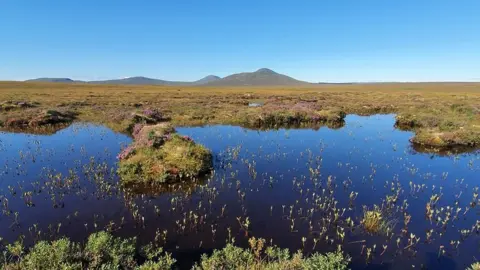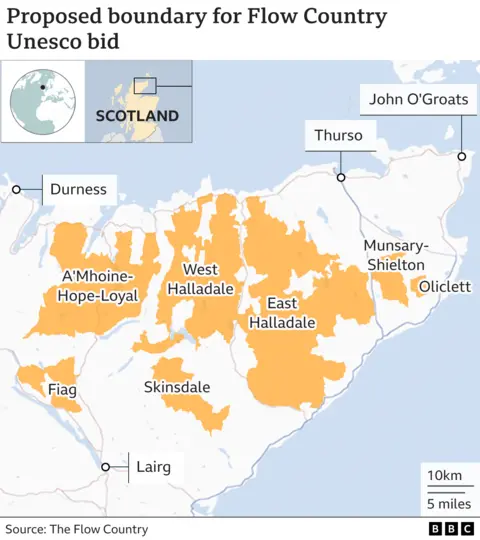Formal bid made for Flow Country Unesco status
 Flow Country Partnership
Flow Country PartnershipUnesco has been formally asked to consider awarding World Heritage Site status to 469,500 acres (190,000ha) of Scotland's Flow Country.
The area of Caithness and Sutherland contains the most intact and extensive blanket bog system in the world.
World Heritage status is an internationally-recognised designation given to places of cultural, historical or scientific significance.
A decision on the Flow Country's nomination is expected next year.
Scottish locations with the Unesco status include the St Kilda archipelago, Skara Brae prehistoric village and the Antonine Wall. Globally, the sites include Australia's Great Barrier Reef and Egypt's Historic Cairo.
The Flow Country Partnership, a collaboration that includes Highland Council, NatureScot, RSPB Scotland, University of the Highlands and Islands and Wildland Ltd, handed its 250-page nomination dossier to the UK government.
It was then submitted to Unesco, a UN organisation promoting cooperation on education and science, for consideration.
Dr Steven Andrews, of the Flow Country Partnership, said: "A vast amount of work has gone into getting the nomination dossier prepared for delivery to Unesco in Paris and we are hugely grateful to both the UK government and also the Scottish government for the support they have provided in helping us reach this important milestone."

UK Arts minister Lord Parkinson of Whitley Bay said the Flow Country would be a worthy recipient of World Heritage Site status.
Scotland's environment minister Mairi McAllan added the peatlands played an important part in combatting climate change.
The Flow Country is an expanse of peatlands, bogs, pools, lochs, hills and mountains covering large parts of the north Highlands.
It is about 50 miles across - roughly the distance from Glasgow to Edinburgh - and covers a total of almost a million acres of land.
The peatlands, which have been growing for 10,000 years, are formed by layers of waterlogged mosses and other vegetation as they die off.
The plant life does not fully decay due to acidic conditions, so the material retains some of the carbon it absorbed when at the surface of the bog.
In places, the peat is 10m thick - deep enough to submerge two double decker buses stacked on top of one another.
The Flows provide habitat for birds, otters and water voles, and is carpeted with sphagnum moss. Its other plant life include sundews, which feed on insects that get trapped in their sticky tentacles.
It helps combat climate change by storing an estimated 400 million tonnes of carbon. Damaging the peat risks releasing harmful greenhouses gases into the atmosphere.
